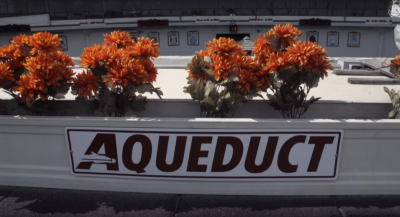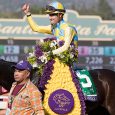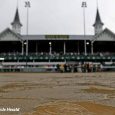 Spring is finally here and since better racing and wagering will soon be returning to New York, this seems like a good time to take a look at the Aqueduct meet from the winter, so handicappers can try to get a leg up on what to expect this spring in terms of the best running styles, post positions, track biases and jockeys and trainers that should be concentrated on in order to give you the best chances to win.
Spring is finally here and since better racing and wagering will soon be returning to New York, this seems like a good time to take a look at the Aqueduct meet from the winter, so handicappers can try to get a leg up on what to expect this spring in terms of the best running styles, post positions, track biases and jockeys and trainers that should be concentrated on in order to give you the best chances to win.
The 2018 Aqueduct winter schedule is currently scaled down to just three days a week of racing, Fridays through Sundays, until the beginning of April. That will soon change, however, as the return of turf racing and the running of the Wood Memorial usher in spring racing, and the 3-day-a-week winter schedule turns into a 5-day-a-week spring schedule.
Racing finally goes back to Belmont Park on Friday, April 27.
This has been a season of transition for New York horseplayers since the old Aqueduct inner track is gone and all of the racing at The Big A from November through April is all conducted on the same surface — the Aqueduct main track. That is good news for handicappers, because we have a solid collection of stats to help us handicap through the last five months, and New York players no longer need to make the switch from the inner track to the main track, which used to make December-March statistics and track trends worthless when handicapping Aqueduct races in April. Now, everything that happened at Aqueduct all winter is relevant to your handicapping for the remaining five weeks of the week.
This Aqueduct main track has proven to be an entirely new surface than the previous Big A main track as well as the old inner track. The old horses-for-the-course have been replaced with new ones who prefer the new limestone base to the old clay base on the main track.
Races at 6 ½ furlongs and 7 furlongs and one-turn miles have been run all winter, unlike the old days (last year) when only 6-furlong sprints were run all winter. There are no more winter past performances at 1 1/16th miles or 1 mile & 70 yards to mess up your Aqueduct spring handicapping, either. Almost all Aqueduct winter route races were run as one-turn miles — and that trend will continue this spring.
Let’s take a closer look at what to expect the rest of the season at Aqueduct.
Jockeys and Trainers

Dylan Davis
The top human-related stories at Aqueduct as the calendar moves to spring are the battles atop the jockey and trainer standings that could go either way. The riding title has come down to a battle between Manny Franco with 59 wins and Dylan Davis with 46 wins, as of March 26. The trainer’s race sees Rudy Rodriguez with 34 wins and Linda Rice with 32.
The jockey colony changed dramatically at Aqueduct this winter when both Jose Ortiz and Irad Ortiz relocated to Gulfstream for the season. That left the jockey standings up for grabs and, not surprisingly, Manny Franco has taken the best advantage of it for a win percentage of 24. Davis is a clear second and winning at a solid 19 percent clip, but the jockey who has really slipped under the radar this season has been Junior Alvarado, who is third in wins with 41 victories at the meet. Albarado’s 41 wins have come in only 152 mounts, giving him a 27 percent win rate. Not to mention that his average winner pays more than Franco’s and Davis’, making Alvarado the ROI king in the Aqueduct jock’s room this season.
Kendrick Carmouche has also been solid with 35 wins and a 17 percent win percentage, and Paco Lopez has also done well when riding here, clicking 23 times from 115 mounts for 20 percent. Everyone else on the list has proven to be unreliable throughout the season as a whole. Things will change dramatically, of course, after the Florida Derby and then Keeneland, when prominent riders such as Johnny Velazquez, Javier Castellano, Luis Saez, Joel Rosario, and the Ortiz’s all return to New York.
Just like in the jockey standings, the trainer’s race has also been very competitive, especially in the battle for the title between Rice and Rodriguez, who are way out in front. Rice has 32 wins and leads in terms of win rate at 28 percent and ITM percentage with 65 percent in the money. This is a remarkable season considering the adversity her barn has faced this winter (equine herpes quarantine, etc.). Rodriguez has also been plugging along consistently with 25 percent wins for the meet. Both trainers’ winners usually pay low prices, however, so you will need to dig deeper in terms of trainers if you are to cash in at Aqueduct.
Trainers doing well enough at Aqueduct to actually offer some value this season have included Jeremiah Englehart (19 wins, 25 percent), Michelle Nevin (10 wins, 24 percent), and Robertino Diodoro (9 wins, 21 percent).
Other barns to watch out for that have made positive impacts with a more limited number of starters at the meet have included Danny Gargan (6 wins, 33 percent), Gary Gullo (6 wins, 25 percent), Jimmy Jerkens (5 wins, 22 percent), Raymond Handal (5 wins, 29 percent), Brad Cox (4 wins, 24 percent), Tom Morley (4 wins, 22 percent), and Kelly Breen (4 wins, 29 percent).
On the flip side, some trainers posting awful numbers this season have included Gary Contessa (11 percent), Carlos Martin (10 percent), David Cannizzo (9 percent) and Mark Hennig (9 percent). Burning the most money so far have been Steve Asmussen (2-for-23, 9 percent), and surprisingly Jason Servis (4-for-35, 11 percent).
Prevailing Biases: Running Styles and Post Positions
Less than five months into its existence, the new Aqueduct main track has played fairly this season to all running styles — a far cry from the old Aqueduct inner track which usually favored speed. Now, however, speed horses appear to have no real advantage against pressers, stalkers, or closers based only in their running style. As a matter of fact, if anything, off-the-pace runners seem to have a slight edge.
Aqueduct’s main track has, however, often shown itself to be at the mercy of anti-inside track biases throughout the meet. Aside from the apparent prevailing daily bias against the inside paths, the track has shown various stronger biases and favoritisms since opening at the start of November. If there is one track trend that handicappers must note on the new Aqueduct main track, it is that the rail and inside paths 1-2 have generally not been the place to be, except for on some bias days when the rail has been good. The overall prevailing bias of the Aqueduct main track this season has definitely been against inside paths on a day-to-day basis, and you definitely must factor this into your handicapping.
The big handicapping angle to come out of this is to look for horses exiting subpar efforts with inside trips in their recent past performances. Horses that lost with inside trips in their last start should usually be upgraded next time out (unless it was one of the inside-bias days). In other words, bet back horses exiting inside trips, and bet against horses exiting perfect outside trips last time out.
The slow rail on the Aqueduct main track has not really affected post position statistics to date, mainly because field sizes have been small and horses can usually work out trips off the rail even if they draw post 1 or 2. The jockeys all know to stay off the inside for the most part, so the post position statistics have mostly been fair.
The Aqueduct post position trends worth noting for handicappers is that the inside (and some middle) posts have been better in both routes and sprints. According to the statistics, horses drawing posts 1-6 have much better chances to win in sprints than the outside horses. In routes there doesn’t seem to be a dramatic drop-off the wider you go, other than just to say that the inside posts 1-4 clearly have the better win percentages. Most of the Aqueduct routes this season have been miles (one turn), but the inside draws are especially good in the two-turn races.

Aqueduct Track Biases
Aqueduct often is at the mercy of daily track biases, and not surprisingly, the track has shown various favoritisms since opening early in December. Refer to my track biases chart below detailing biased days since the start of the year.
March 10 – Speed good.
March 4 – Outside probably the best part of the track.
Feb. 24 – Gold rail in the rain got even better when sealed races 6-7.
Feb. 23 – Inside and rail advantage on muddy track.
Feb. 18 – Horses stayed off the rail.
Feb. 17 – Horses stayed off the rail.
Feb. 16 – Had to stay off the rail in slop; outside good.
Feb. 3 – Inside good.
Jan. 26 – Gold rail inside bias; speed good.
Jan. 25 – Horses benefited from avoiding the rail.
Jan. 21 – Dead slow track killed inside speed, outside advantage.
Jan. 20 – Inside bias.
Jan. 18 – Inside advantage in routes.
The outside paths generally enjoy an advantage at Aqueduct and the jockeys often avoid rail trips. The above list details certain days when the rail and/or inside paths have been exceptionally bad, or in some cases, such as on Feb. 23-24 and on Feb. 3 and Jan. 26, when the rail and inside paths were actually good. Factor these bias days into your handicapping and you will definitely win more races and pick better-priced winners than the players who ignore this kind of valuable information.
Wrap-Up
Good luck during the Aqueduct winter/spring meet, and enjoy the rest of the season. It has been a long, cold, and snowy winter in New York, but it is already late March and there is a light at the end of the tunnel, with better horses and jockeys on their way back to New York shortly along with the top trainers who will soon head back to Aqueduct and Belmont following Gulfstream and Keeneland.
Use these tips to raise your success rate at Aqueduct the rest of the way, and enjoy what’s left of the season at Aqueduct.
Best of luck!



